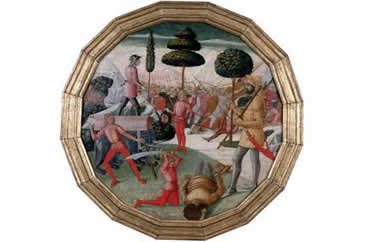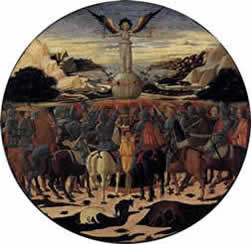Rachel Baker
Chicago, IL
Recurring outbreaks of plague and their resulting demographic catastrophes largely contributed to the Renaissance emphasis on family and procreation. After the initial epidemic in 1348, the plague returned more than a dozen times over the next two centuries. Childbirth was seen as a vital measure to combat plague’s devastation, and a woman’s most important duty was to produce children, especially male heirs, to ensure the continuity of her husband’s patrimony. Childbirth did not come without risks to the infant, however, and the crucial first days following birth were characterized by high infant mortality. For these reasons, childbirth was encouraged, celebrated, and commemorated with a variety of objects, such as painted wooden birth trays or desco da parto.
Birth trays began to appear about 1370 in Italy and became particularly popular in 15th century Florentine and Sienese society. Wealthy families commissioned lavishly painted confinement scenes with suitable religious, mythological, or literary themes. Serial stock production of birth trays in workshops also permitted common people to buy them at the birth of their child. Birth trays were painted on both sides, sometimes with coats of arms or board games in the back. Either round or multi-sided, they measured about 50 to 60 cm in diameter (about 19 to 24 inches).

Bartolomeo Di Fruosino
Tempera on panel
New York Historical Society

Tempera on panel
Loyola University Museum of Art, Martin D’Arcy Collection

Lo Scheggia
Tempera, silver, and gold on wood
Metropolitan Museum of Art
To influence a healthy birth and even the gender of the baby, an expectant mother was encouraged to reflect on the narrative of her desco. Immediately following the birth, the desco was covered with a protective cloth, laden with nourishing food, and presented to the mother for her swift recovery (See Figure 1). This birth tray depicts a mother sitting up in bed to receive guests. She has a draped tray on the coverlet beside her.
Following the birth ceremony, the family often hung the desco in their home, usually in the bedroom, as a painting. The bedroom, or camera, was an important part of the house, where large gatherings took place. Later, the desco would serve an educational function to the growing child. For example, a “David and Goliath” theme would convey wishes of courage and bravery for the child, probably a son, persuading him to emulate the valor of the hero depicted on the tray (See Figure 2).
Birth trays were not offered only at the birth of a child. They often also served as gifts to newlywed couples, with the implied message that the bride should reflect on her maternal duty. These objects were guarded preciously long after the child had grown into adulthood. For example, Lorenzo de Medici, ruler of the city of Florence, kept his desco, which depicted the Triumph of Fame, in his private quarters till his death (See Figure 3).
These trays, symbols of fertility and rewards for a healthy birth, became outmoded by the end of the 16th century. However, birth objects did not completely fall into disfavor, as majolica birth bowls continued to remain popular into the 17th century.
Reference
- Musacchio, Jacqueline Marie. 1999. The Art and Ritual of Childbirth in Renaissance Italy. New Haven: Yale University Press.

Leave a Reply